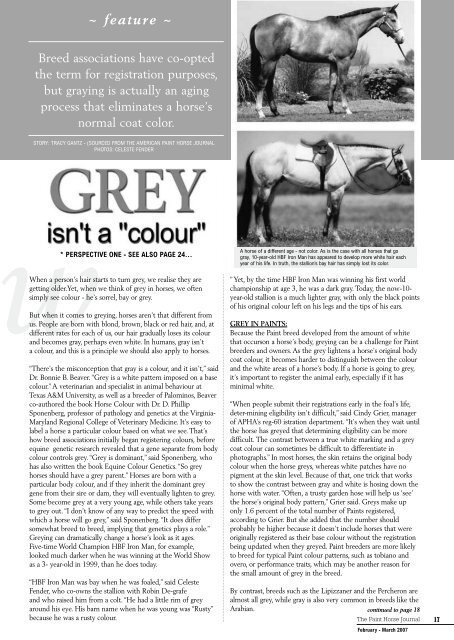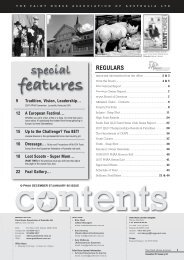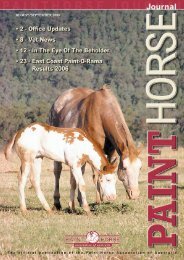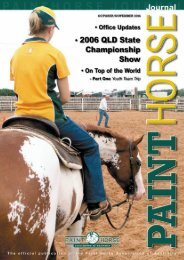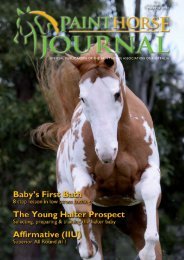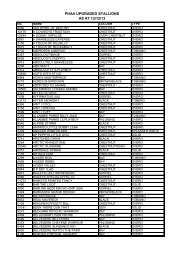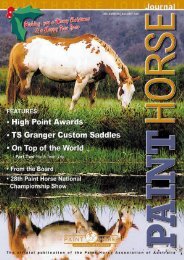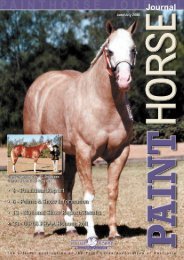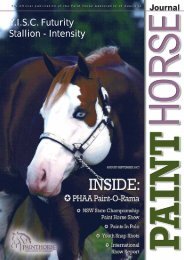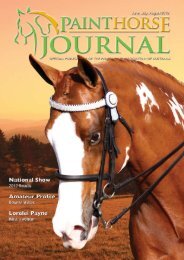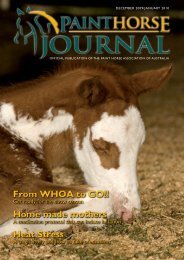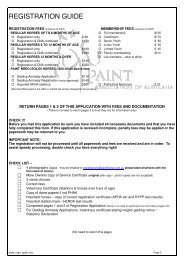PH - Paint Horse Association of Australia
PH - Paint Horse Association of Australia
PH - Paint Horse Association of Australia
You also want an ePaper? Increase the reach of your titles
YUMPU automatically turns print PDFs into web optimized ePapers that Google loves.
~ feature ~<br />
Breed associations have co-opted<br />
the term for registration purposes,<br />
but graying is actually an aging<br />
process that eliminates a horse’s<br />
normal coat color.<br />
STORY: TRACY GANTZ - (SOURCED FROM THE AMERICAN PAINT HORSE JOURNAL<br />
<strong>PH</strong>OTOS: CELESTE FENDER<br />
* PERSPECTIVE ONE - SEE ALSO PAGE 24...<br />
When a person’s hair starts to turn grey, we realise they are<br />
getting older.Yet, when we think <strong>of</strong> grey in horses, we <strong>of</strong>ten<br />
simply see colour - he’s sorrel, bay or grey.<br />
But when it comes to greying, horses aren’t that different from<br />
us. People are born with blond, brown, black or red hair, and, at<br />
different rates for each <strong>of</strong> us, our hair gradually loses its colour<br />
and becomes gray, perhaps even white. In humans, gray isn’t<br />
a colour, and this is a principle we should also apply to horses.<br />
“There’s the misconception that gray is a colour, and it isn’t,” said<br />
Dr. Bonnie B. Beaver. “Grey is a white pattern imposed on a base<br />
colour.” A veterinarian and specialist in animal behaviour at<br />
Texas A&M University, as well as a breeder <strong>of</strong> Palominos, Beaver<br />
co-authored the book <strong>Horse</strong> Colour with Dr. D. Phillip<br />
Sponenberg, pr<strong>of</strong>essor <strong>of</strong> pathology and genetics at the Virginia-<br />
Maryland Regional College <strong>of</strong> Veterinary Medicine. It’s easy to<br />
label a horse a particular colour based on what we see. That’s<br />
how breed associations initially began registering colours, before<br />
equine genetic research revealed that a gene separate from body<br />
colour controls grey. “Grey is dominant,” said Sponenberg, who<br />
has also written the book Equine Colour Genetics. “So grey<br />
horses should have a grey parent.” <strong>Horse</strong>s are born with a<br />
particular body colour, and if they inherit the dominant grey<br />
gene from their sire or dam, they will eventually lighten to grey.<br />
Some become grey at a very young age, while others take years<br />
to grey out. “I don’t know <strong>of</strong> any way to predict the speed with<br />
which a horse will go grey,” said Sponenberg. “It does differ<br />
somewhat breed to breed, implying that genetics plays a role.”<br />
Greying can dramatically change a horse’s look as it ages.<br />
Five-time World Champion HBF Iron Man, for example,<br />
looked much darker when he was winning at the World Show<br />
as a 3- year-old in 1999, than he does today.<br />
“HBF Iron Man was bay when he was foaled,” said Celeste<br />
Fender, who co-owns the stallion with Robin De-grafe<br />
and who raised him from a colt. “He had a little rim <strong>of</strong> grey<br />
around his eye. His barn name when he was young was “Rusty”<br />
because he was a rusty colour.<br />
A horse <strong>of</strong> a different age - not color. As is the case with all horses that go<br />
gray, 10-year-old HBF Iron Man has appeared to develop more white hair each<br />
year <strong>of</strong> his life. In truth, the stallion’s bay hair has simply lost its color.<br />
” Yet, by the time HBF Iron Man was winning his first world<br />
championship at age 3, he was a dark gray. Today, the now-10-<br />
year-old stallion is a much lighter gray, with only the black points<br />
<strong>of</strong> his original colour left on his legs and the tips <strong>of</strong> his ears.<br />
GREY IN PAINTS:<br />
Because the <strong>Paint</strong> breed developed from the amount <strong>of</strong> white<br />
that occurson a horse’s body, greying can be a challenge for <strong>Paint</strong><br />
breeders and owners. As the grey lightens a horse’s original body<br />
coat colour, it becomes harder to distinguish between the colour<br />
and the white areas <strong>of</strong> a horse’s body. If a horse is going to grey,<br />
it’s important to register the animal early, especially if it has<br />
minimal white.<br />
“When people submit their registrations early in the foal’s life,<br />
deter-mining eligibility isn’t difficult,” said Cindy Grier, manager<br />
<strong>of</strong> A<strong>PH</strong>A’s reg-60 istration department. “It’s when they wait until<br />
the horse has greyed that determining eligibility can be more<br />
difficult. The contrast between a true white marking and a grey<br />
coat colour can sometimes be difficult to differentiate in<br />
photographs.” In most horses, the skin retains the original body<br />
colour when the horse greys, whereas white patches have no<br />
pigment at the skin level. Because <strong>of</strong> that, one trick that works<br />
to show the contrast between gray and white is hosing down the<br />
horse with water. “Often, a trusty garden hose will help us ‘see’<br />
the horse’s original body pattern,” Grier said. Greys make up<br />
only 1.6 percent <strong>of</strong> the total number <strong>of</strong> <strong>Paint</strong>s registered,<br />
according to Grier. But she added that the number should<br />
probably be higher because it doesn’t include horses that were<br />
originally registered as their base colour without the registration<br />
being updated when they greyed. <strong>Paint</strong> breeders are more likely<br />
to breed for typical <strong>Paint</strong> colour patterns, such as tobiano and<br />
overo, or performance traits, which may be another reason for<br />
the small amount <strong>of</strong> grey in the breed.<br />
By contrast, breeds such as the Lipizzaner and the Percheron are<br />
almost all grey, while gray is also very common in breeds like the<br />
Arabian.<br />
continued to page 18<br />
The <strong>Paint</strong> <strong>Horse</strong> Journal 17<br />
February - March 2007


